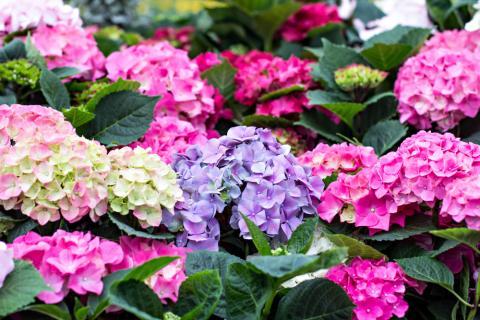
Hydrangea are a member of the family Hydrangeaceae, commonly known as the Hydrangea family of the genus Hydrangea L. or hydrangea P., containing six species according to the United States Department of Agriculture. The plant is native to the southern and eastern regions of Asia and the Americas and many horticulturists believe that the genus contains approximately one hundred species. They are easily grown in the garden and add texture and color to landscaping. The name hydrangea was derived from the Greek language “hydros” meaning water and “angos” meaning jar because the plant needs to be moist. Due to the fact that the Emperor of Japan gave them to his ladies as an apology, the flower is a symbol of apology or gratitude in that country. This is the total opposite in Europe, where it is said that if a woman grows hydrangeas they will never marry. The plant is primarily a decorative landscape plant and it has also been used for medicinal purposes by monks in Asia and the Native Peoples of the Americas.
Hydrangea flowers are small and group together at the end of the stem; the colors are enhanced by a ring of modified leaves known as bracts supporting each flower. The blossoms are usually white but can be purple, blue, red, or pink, depending on the acidity of the soil; acid soil produces pale cream-colored petals while alkaline soil results in pink or purple petals. There are three types of hydrangea flowers: the mophead has a sphere-shaped cluster of flowers; the panicle has cone-shaped clusters; the lacecap produces a flat cluster of what appears to be immature buds that are encircled by four to five flowers with evident petals. Hydrangeas can grow in shrub form, as trees, and there are vining varieties. Depending on the variety their leaves can be simple, serrate, estipulate, entire, or pinnately lobed; their shapes vary from ovate to oblong and the upper surface of the leaf can be glossy, hairy, matte, or smooth with the lower portion dull containing a network of pinnate veins. Seeds are contained in small two-to-five celled capsules and can be in the shape of a turban, truncate, sphere, or apex projected. Each cell contains many tiny seeds that can be elongated, winged, or wingless and each seed has a thin seed coat with reticulate or striate veins.
Note: Hydrangeas can be toxic to dogs, cats, and horses; gastrointestinal upset is most likely, but cyanide poisoning can occur, so limit animals’ exposure to these plants.
Growing hydrangeas in the garden
Hydrangeas are a beautiful addition to any garden and are easily grown. They do well in full sunlight in colder climates and prefer morning sunlight and afternoon shade in warmer regions. They need fertile soil and they should be transplanted from the pot to the depth of the pot and twice the width. Apply approximately two inches of mulch around the plant to maintain moisture and keep the soil cool. To care for the plant check to be sure the soil is cool and moist and do not overwater because soggy soil will result in root rot.
The many ways to use hydrangeas
Hydrangeas do well as container plants and add to the décor of a room, porch, or patio. It is advised to use the compact varieties like the Penny Mac in a container that drains well; be sure to keep the soil moist for a full bouquet. Hydrangeas can also become trees by pruning the shrub variety like the PeeGee which will grow to approximately twenty-two feet tall and produce white summer flowers that mature to a rose hue. For smaller trees the dwarf variety like the Limelight will reach a height of eight feet. Hydrangeas also have vining varieties that need support and bring color and fragrance to patio areas or as a back drop for a flower garden. A masonry wall or a large tree trunk gives the plant a good surface for their aerial roots to take hold; varieties like the Firefly or the Moonlight are recommended.
Hydrangeas as a healing plant
Hydrangeas have been cultivated by native peoples in the Americas and in Asia for centuries for their roots and rhizomes. The roots can be dried for use as tea, powdered to encapsulate, or used as a tincture. There are many healing uses for hydrangeas that include but are not limited to reducing swollen prostates, preventing bladder infections, dissolving kidney and gallbladder stones, lowering inflammation, soothing the pain of gout and rheumatoid arthritis, and preventing autoimmune diseases.








